Sun-dried foods offer you an incredibly sustainable and cost-effective way to preserve your harvest. You'll save up to 75% compared to mechanical drying methods, with initial setup costs as low as $57 for a basic solar dryer. You won't need electricity or fuel, and you'll help reduce food waste by up to 50%. While some vitamins may decrease during drying, you'll retain concentrated nutrients and stable minerals like iron. With proper tools and techniques, you can extend your food's shelf life for months without refrigeration. Let's explore how this ancient preservation method can transform your modern kitchen.
Understanding Solar Food Preservation
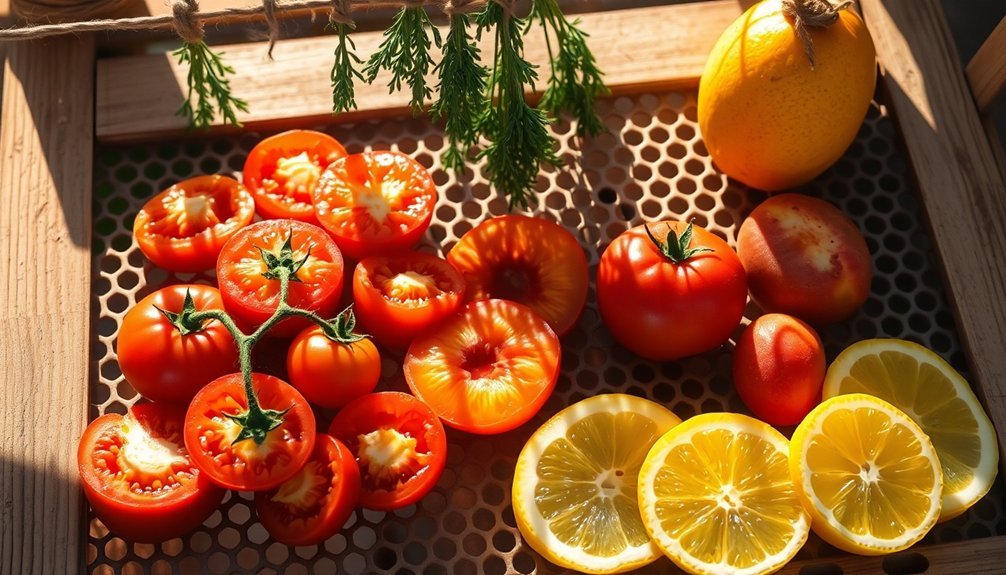
While traditional food preservation methods have existed for centuries, solar food preservation represents a sustainable and efficient approach to drying food using the sun's energy.
You'll find that solar dryers come in various forms, from simple designs to sophisticated systems that maximize the sun's power. You can choose between direct solar dryers, which expose food straight to sunlight, or indirect systems that use complex heat distribution methods.
Both types protect your food while removing moisture effectively. The process is remarkably safe, helping preserve vitamin C content by using radiated heat and shielding food from harmful UV rays.
What's more, the naturally low pH and moisture content of solar-dried foods prevents spoilage microorganisms from growing. You'll appreciate how this method helps retain more flavor and nutrients compared to conventional drying techniques. Using solar dryers offers minimal operational costs compared to electric or gas-powered alternatives.
Benefits of Sun Drying
Numerous benefits make sun drying an attractive food preservation method. When you sun-dry foods, you'll preserve their nutritional value while concentrating vitamins, minerals, and antioxidants. This natural preservation method extends shelf life appreciably, allowing you to store foods for months without refrigeration while taking up less space. The optimal temperature of 85°F or higher ensures effective moisture removal for preservation.
- Enhances natural flavors and creates versatile ingredients for cooking
- Retains essential nutrients and makes them more bioavailable
- Requires no electricity, making it environmentally friendly and cost-effective
- Helps reduce food waste by preserving surplus seasonal produce
- Supports self-sufficiency and sustainable living practices
The process intensifies flavors, creating unique ingredients that'll add depth to your dishes. You'll also save money while contributing to environmental sustainability, as sun drying doesn't require electricity or produce greenhouse gas emissions.
Essential Tools and Equipment
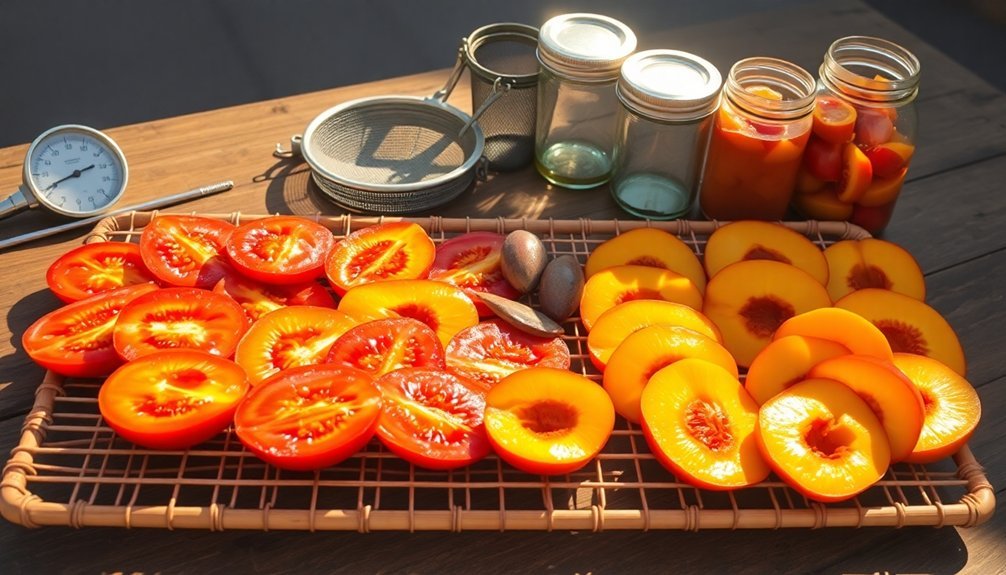
You'll need some basic equipment to get started with sun drying, including black plastic sheets for heat absorption, clear polyethylene coverings, and sturdy support poles.
Building the dryer in a flat, sunny location will ensure optimal drying conditions throughout the day.
Your storage containers should be airtight, moisture-proof, and food-grade to maintain the quality of dried foods after processing.
For the drying racks, select UV-resistant mesh or food-grade materials that allow proper air circulation while keeping insects and debris away from your produce.
Basic Equipment List
Success in sun-drying food begins with having the right equipment on hand. You'll need proper racks and screens made from food-safe materials like stainless steel or Teflon-coated fiberglass, while avoiding galvanized metal, copper, or aluminum.
Don't forget protective coverings like cheesecloth to shield your food from insects and birds.
Essential items for your sun-drying project:
- Sharp knife and cutting board for precise food preparation
- Food-safe drying racks elevated on blocks for air circulation
- Clean cheesecloth or additional screens for protection
- Spatula for turning and handling produce
- Lemon juice or red wine vinegar to prevent browning
Remember to position your setup in a hot, dry area with good airflow, and bring your produce inside at night to protect it from moisture.
Using reflective surfaces can help increase drying temperatures for better results.
Place your drying racks on concrete or metal surfaces to prevent unwanted moisture from seeping up from the ground.
Storage Container Selection
Proper storage containers make the difference between well-preserved sun-dried foods and spoiled products.
You'll want to invest in high-quality glass containers for their non-porous nature, though BPA-free plastic options work well too. Look for containers with airtight seals, preferably silicone, to keep moisture out and freshness in.
Choose a variety of sizes to accommodate different quantities. Large containers are perfect for bulk storage of dried fruits, while smaller ones suit herbs and spices.
Make sure your containers are dishwasher-safe and can withstand temperature changes if you plan to reheat foods. Don't forget to check that they're stackable to maximize your storage space.
For best results, store your containers in a cool, dry place between 50°F and 60°F, and always label them clearly.
Drying Rack Requirements
Three essential components define an effective drying rack setup for sun-dried foods: material quality, placement strategy, and air circulation.
You'll want to choose stainless steel or Teflon-coated fiberglass racks, avoiding copper and aluminum materials that can compromise food quality.
Position your racks on a level concrete surface or over metal sheets, elevated with blocks to promote airflow. Remember to keep food pieces single-layered with adequate spacing for ideal drying.
- Double-screen system: one for support, one for protection against birds and insects
- Cheesecloth covering for additional pest control
- Reflective surfaces to enhance sun exposure
- Strategic positioning away from shadows
- Proper ventilation setup with optional fan support for larger operations
These requirements guarantee your sun-dried foods maintain quality while preventing contamination from environmental factors.
Best Foods for Drying
When selecting foods for sun drying, certain fruits and vegetables perform better than others due to their natural composition and moisture content. You'll find that apricots, grapes, dates, and figs are excellent choices for sun drying because of their high sugar content and natural acidity. These fruits dry efficiently and maintain their flavors well.
For vegetables, you can't go wrong with tomatoes, mushrooms, and zucchini. They're easy to prepare and versatile in cooking once dried. Just remember to cut them into uniform pieces for even drying.
While you might be tempted to dry everything under the sun, some foods aren't suitable for outdoor drying. Keep meats, fatty foods, and leafy greens indoors, where you can control the drying conditions better.
Instead, focus on fresh, blemish-free produce that's properly ripened and cleaned.
Step by Step Drying Process
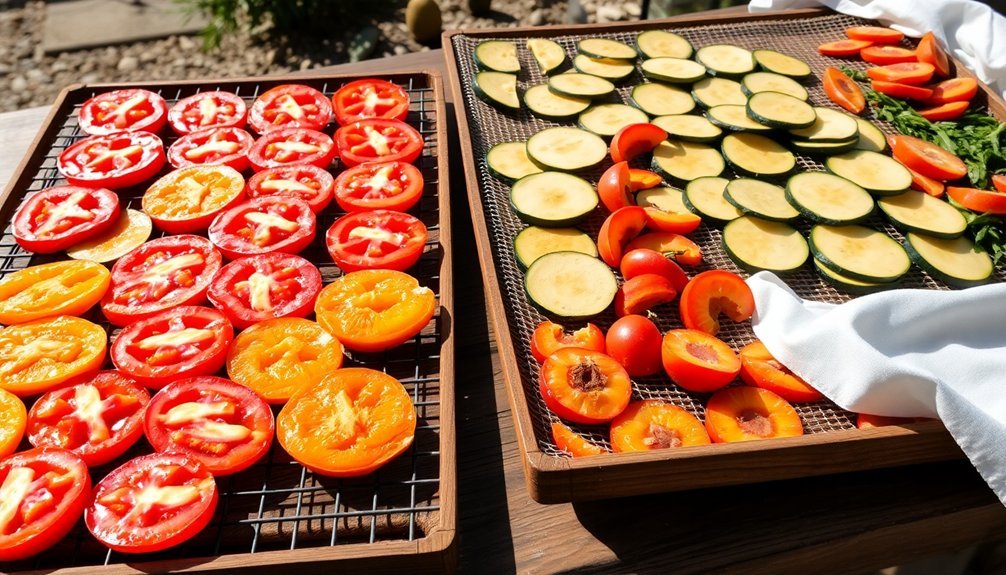
Now that you've selected the right foods for drying, mastering the step-by-step process will guarantee your success.
Begin by thoroughly washing your produce and cutting it into uniform pieces. After blanching vegetables to preserve nutrients, pat everything dry and arrange it on elevated trays for ideal air circulation.
- Place trays in direct sunlight, but protect from intense afternoon heat
- Cover produce with cheesecloth to keep insects away
- Maintain temperatures between 60°F and 80°F
- Rotate trays regularly for even drying
- Check for proper dryness – items should be flexible but not sticky
Monitor the process daily, as drying can take several days depending on humidity and weather conditions.
Once your food reaches the right consistency, cool it immediately and store it in airtight containers, clearly labeled with dates and contents.
Storage and Safety Tips
When storing your sun-dried foods, you'll need airtight containers such as glass jars, food-grade plastic containers, or vacuum-sealed bags to maintain quality and prevent moisture absorption.
You'll get the best results by keeping your stored items in a cool, dark place with temperatures between 50°F to 60°F and humidity levels below 60%.
Fill your chosen containers as full as possible to minimize air space, but don't crush the contents in the process.
Proper Storage Containers
Three key factors determine the success of storing sun-dried foods: container material, sealing quality, and proper handling.
You'll want to select containers made of plastic, glass, or ceramic that feature airtight seals to protect your dehydrated goods from moisture and pests.
Choose containers with wide mouths for easy access and guarantee they're stackable to maximize your storage space.
- Opt for snap-on lids that create a reliable seal while remaining easy to open
- Select containers that are both dishwasher and freezer safe for versatility
- Look for handles on larger containers to make moving bulk items easier
- Choose sturdy, non-leak designs to prevent spills and contamination
- Pick containers in various sizes to accommodate different quantities of dried foods
Remember to store your containers in a cool, dark place and regularly inspect them for damage or wear.
Temperature and Humidity Control
Maintaining proper temperature and humidity levels stands as the cornerstone of successfully storing sun-dried foods.
You'll want to keep your dried goods in a cool environment between 50°F and 60°F (10°C to 15°C), though room temperature can work if that's your only option. Find a dark pantry or closet away from heat sources and direct sunlight.
Monitor your storage area's humidity levels carefully – they should stay below 60%. Use hygrometers and thermometers to track these conditions, as high humidity can trigger mold growth and spoilage.
If you're aiming for maximum shelf life, consider freezing your dried foods, which can preserve them for up to two years.
Remember to guarantee good ventilation in your storage space, as proper air circulation helps maintain ideal conditions for your sun-dried treasures.
Common Mistakes to Avoid
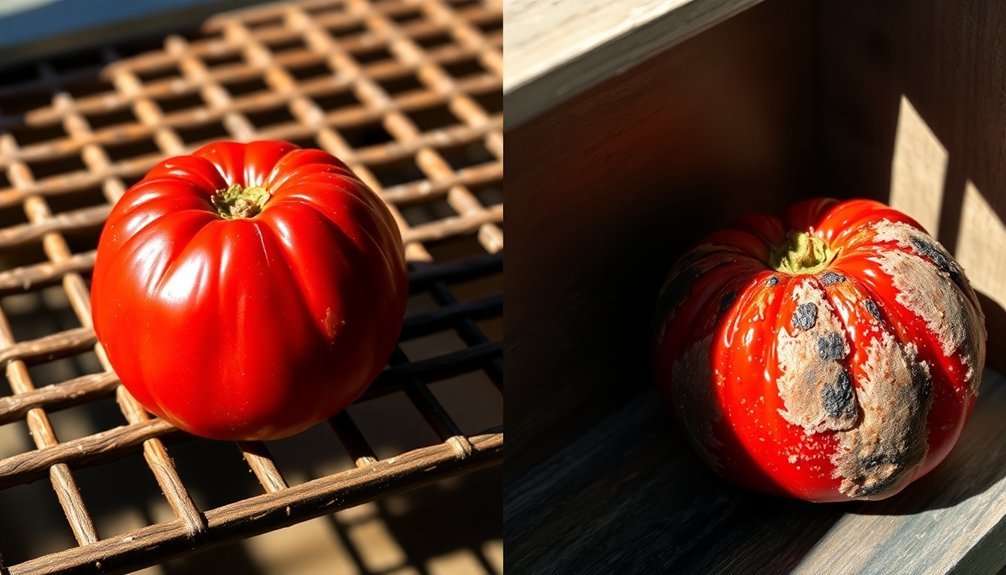
Despite the simplicity of sun-drying foods, several vital mistakes can compromise the quality and safety of your preserved goods. To guarantee success, you'll need to avoid overcrowding your dehydrator, maintain proper temperature settings, and carefully prepare your foods.
Remember that proper storage is essential for maintaining the quality and safety of your sun-dried products over time.
- Don't pack foods too tightly – leave space for proper air circulation
- Monitor temperature consistently and adjust based on food type
- Avoid dehydrating high-moisture or fatty foods like melons and avocados
- Ensure foods are completely dry before storage to prevent spoilage
- Store your dried goods in cool, dry conditions and check regularly for signs of deterioration
Understanding these common pitfalls will help you create high-quality sun-dried foods that maintain their flavor and nutritional value.
Nutritional Value Retention
While sun-drying can lead to some vitamin loss, particularly vitamins A and C, you'll still benefit from the concentrated nutrients that remain in these preserved foods.
You can maximize vitamin retention by carefully controlling the drying conditions and using the rehydration liquid when preparing dried foods.
The concentrated mineral content in sun-dried foods makes them particularly valuable, as essential minerals like iron remain stable throughout the drying process.
Vitamin Preservation Through Drying
The preservation of vitamins during sun-drying presents significant challenges, as exposure to heat, air, and sunlight can dramatically reduce nutritional content.
You'll notice the most significant losses in vitamin C, with up to 97.5% reduction after three days, while vitamin A and carotenoids can diminish by up to 89%.
However, you can minimize these losses through proper preparation and timing.
- Pre-treat your produce with citrus juice or citric acid to help retain vitamin C
- Process fruits and vegetables immediately after harvest for maximum nutrient retention
- Consider blanching in hot water to preserve carotene and thiamine
- Use sulfur dioxide treatments to protect vitamins A and C (except for organic foods)
- Opt for controlled indoor dehydration when possible, as it preserves more nutrients than sun-drying
Concentrated Mineral Content Benefits
Most minerals remain remarkably stable during sun-drying, becoming concentrated as water evaporates from food. You'll find impressive levels of calcium, magnesium, phosphorus, potassium, iron, and zinc in sun-dried products.
For instance, sun-dried leafy vegetables can provide up to 50% of your daily mineral requirements after just three days of drying.
You'll boost your mineral intake considerably with sun-dried tomatoes, which are rich in potassium, magnesium, and iron. They're also packed with highly bioavailable lycopene, offering enhanced protection against certain cancers.
While some sun-dried foods contain anti-nutrients like oxalates and phytates, you can minimize their effects through proper preparation methods such as soaking or boiling.
Cost Savings Analysis
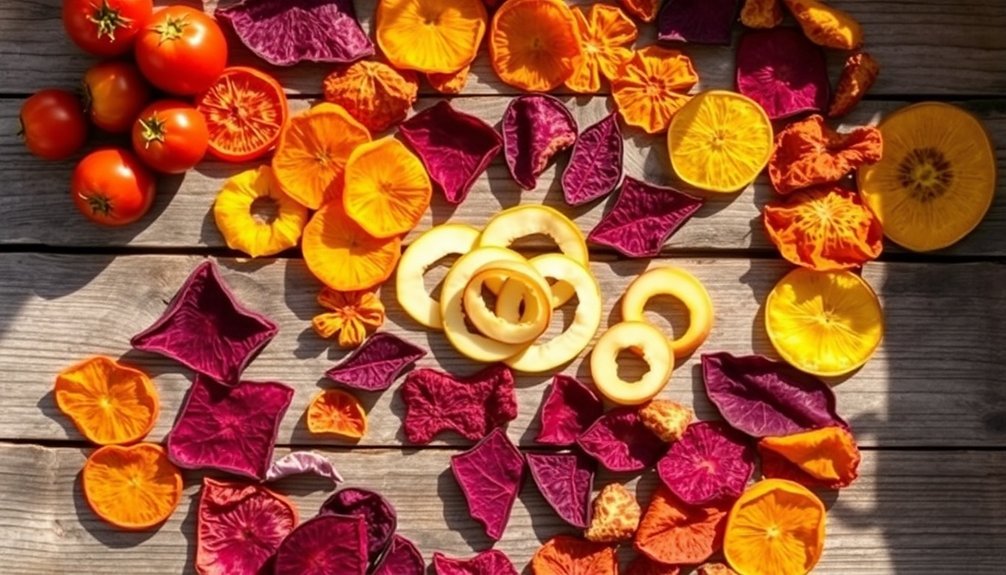
Among available food preservation methods, sun-drying stands out as an exceptionally cost-effective solution, offering savings of up to 75% compared to mechanical drying techniques.
You'll spend less than half of what you'd pay for flat bed drying, and your initial investment can be spread across years of use. The process minimizes labor costs by harnessing natural solar energy instead of expensive mechanical or electrical power.
- Initial setup costs can be as low as $57 for a basic solar dryer
- No ongoing electricity or fuel expenses
- Higher profit margins due to reduced operating costs
- Market potential for dried vegetables and fruits
- Blanching combined with sun-drying offers one of the most economical preservation methods
The cost benefits don't compromise quality – proper pre-processing and storage techniques guarantee your sun-dried foods retain their nutritional value and marketability.
Environmental Impact
While many food preservation methods strain environmental resources, sun-drying stands out as a zero-emission solution that harnesses nature's power. You'll reduce your carbon footprint considerably by choosing this method, as it requires no electricity, fossil fuels, or manufactured equipment.
| Environmental Benefit | Impact |
|---|---|
| Energy Consumption | Zero electricity needed |
| Resource Conservation | Prevents deforestation and water waste |
| Food Security | Reduces waste by up to 50% |
When you sun-dry foods, you're not just preserving nutrients – you're contributing to a sustainable food system. This method prevents post-harvest losses, extends shelf life, and supports local food production. You'll also help maintain better air quality by avoiding fossil fuels and biomass burning. It's an eco-friendly choice that empowers you to preserve food independently while protecting the environment.
Frequently Asked Questions
Can Sun-Dried Foods Trigger Food Allergies Differently Than Fresh Foods?
Yes, you'll find sun-dried foods can trigger stronger allergic reactions because the drying process concentrates allergens. They're also more likely to have cross-contamination during processing than their fresh counterparts.
How Do Different Climate Conditions Affect the Flavor of Sun-Dried Foods?
You'll notice stronger flavors in hot, dry climates as sugars concentrate quickly. In humid conditions, your foods may dry slower, creating milder tastes, while consistent sunlight helps develop rich, complex flavor profiles.
Can Medications Interact Negatively With Concentrated Nutrients in Sun-Dried Foods?
Yes, you'll need to be cautious with sun-dried foods if you're on medications. Their concentrated nutrients can interact with blood thinners, statins, and other drugs. Always consult your doctor about potential interactions.
Are Pesticides More Concentrated in Sun-Dried Foods Compared to Fresh Produce?
Yes, you'll find higher pesticide concentrations in sun-dried foods compared to fresh produce. This isn't because there are more pesticides, but because the dehydration process concentrates existing pesticides into a smaller volume.
Do Sun-Dried Foods Require Different Portion Sizes in Recipes Than Fresh Ingredients?
Yes, you'll need smaller portions of sun-dried foods in your recipes since they're highly concentrated. A small amount packs the same punch as larger quantities of fresh ingredients, so adjust accordingly to avoid overpowering flavors.
In Summary
Sun-dried food preservation isn't just a traditional practice – it's your ticket to sustainable, nutritious eating. You'll save money, reduce your carbon footprint, and preserve seasonal produce at its peak. With minimal equipment and nature's free energy, you've got everything needed to start this rewarding project. Don't wait – transform your excess produce into delicious, shelf-stable foods while maintaining their essential nutrients.

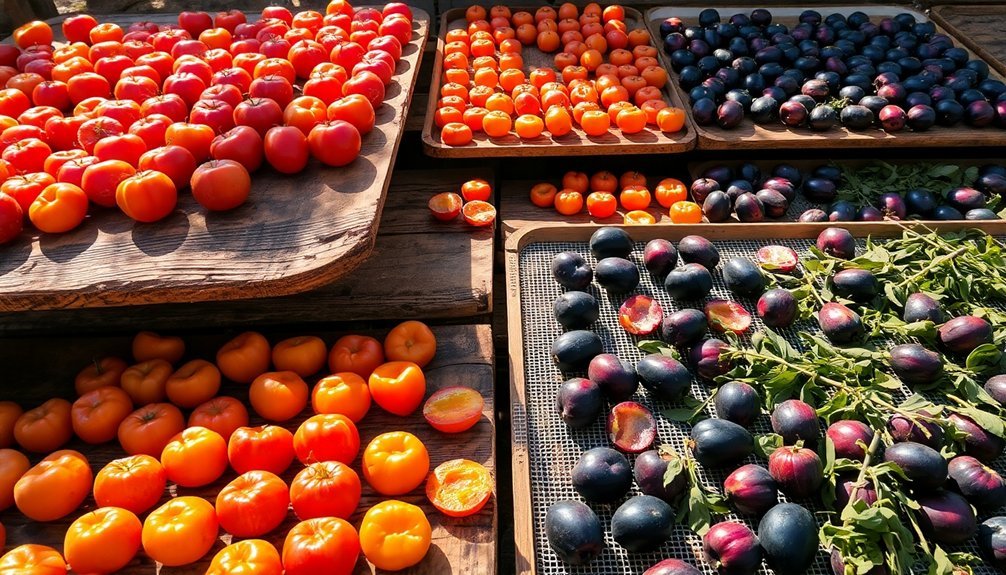



Leave a Reply